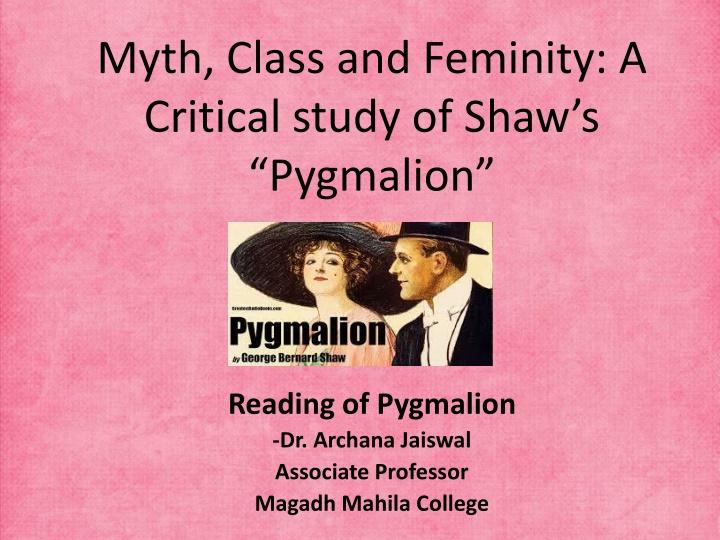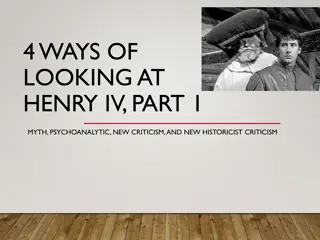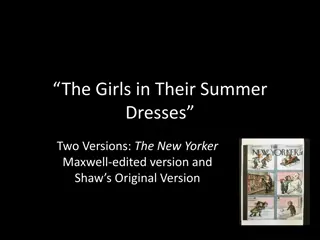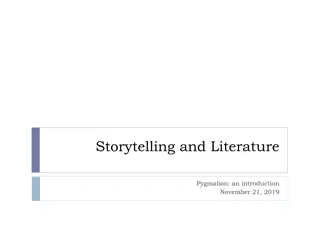Myth, Class, and Femininity: Critical Analysis of George Bernard Shaw's Pygmalion
Explore the insightful examination of Shaw's Pygmalion, delving into themes of myth, class dynamics, and femininity. Analyzing the characters and societal backdrop, the study sheds light on the profound messages conveyed through the play.
Download Presentation

Please find below an Image/Link to download the presentation.
The content on the website is provided AS IS for your information and personal use only. It may not be sold, licensed, or shared on other websites without obtaining consent from the author.If you encounter any issues during the download, it is possible that the publisher has removed the file from their server.
You are allowed to download the files provided on this website for personal or commercial use, subject to the condition that they are used lawfully. All files are the property of their respective owners.
The content on the website is provided AS IS for your information and personal use only. It may not be sold, licensed, or shared on other websites without obtaining consent from the author.
E N D
Presentation Transcript
Myth, Class and Feminity: A Critical study of Shaw s Pygmalion Reading of Pygmalion -Dr. Archana Jaiswal Associate Professor Magadh Mahila College
I must warn my readers that my attacks are directed against themselves, not against my stage figures. - Shaw
George Bernard Shaw Shaw was born in Dublin, Ireland in 1856. He lacked any professional training due to his dislike of it. In 1876 he moved to London and became a music and theatre critic and a member of the Fabian Society. Shaw used his plays to expose the hypocrisy and complacency of British Society.
George Bernard Shaw Shaw was awarded the Nobel Prize for literature in 1925. He is much more the propagandist than the artist because he paints in loud colors. He continued to write until he was 94.
For arts sake alone I would not face the toil of writing a single sentence. -Shaw
Setting of the play London, 1912 During this era, both in the play and in real life, there were huge differences between the rich and the poor. Social classes were clearly defined, and it was hard to move from one class to another. Women did not have the same rights as men and were often looked to as inferior.
Myth of Creation The tale of Pygmalion as written by Ovid is of a gifted young sculptor, Pygmalion who falls in love with his own creation, Galatea and wishes to give his creation life.
Professor Higgins is also like Pygmalion in his view of woman cynical and derogatory; Higgins says, I find that the moment I let a woman make friends with me, she becomes, exacting, suspicious, and a damned nuisance. Shaw s Galatea , Eliza, develops a soul of her own and a fierce independence from her creator.
Class and Society In Pygmalion, we observe a society divided, separated by language, education and wealth.
Shaw satirizes the British concept of social graces and class as being the measure of a person s worth. If you are treated as a member of upper classes, you ll be accepted by them and vice versa. Eliza:- The difference between a lady and a flower girl is not how she behaves, but how she s treated.
The Feminist Perspective Feminism is a very prominent theory throughout the novel. Shaw portrays a society in translation, in which progressive notions of feminity clash with more established traditional idea about gender roles.
As the play ends, we see female dominance over all the males. Eliza has left Higgins and Pickering, finally independent and confident, that she no longer needs them. Five minutes ago you were like a millstone round my neck. Now you re a tower of strength: a consort battleship.
Pygmalion as a Problem Play In Pygmalion, Shaw tackles issues about women s rights, language, social class, gender roles and the idea of self-transformation. Pygmalion explores how social identity is formed not only through the patterns of speech, but through its general appearance. The play itself is memorable because of its vigor and fun, notwithstanding Shaw s protestations about its message.


![❤[PDF]⚡ Civil War Talks: Further Reminiscences of George S. Bernard and His Fel](/thumb/20551/pdf-civil-war-talks-further-reminiscences-of-george-s-bernard-and-his-fel.jpg)




















